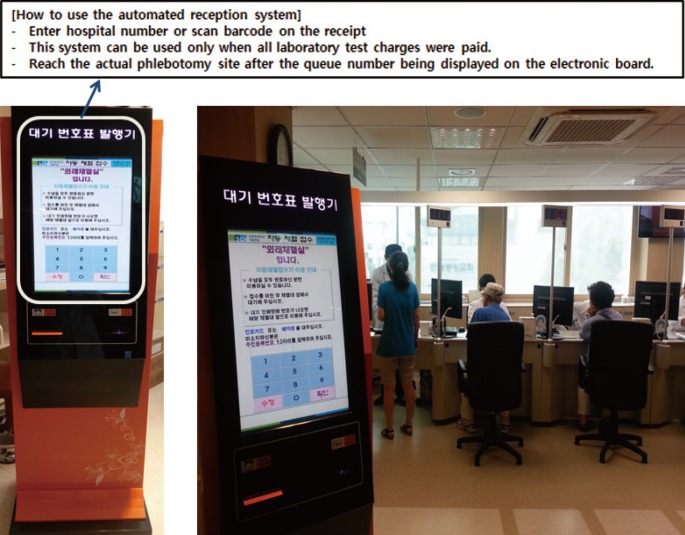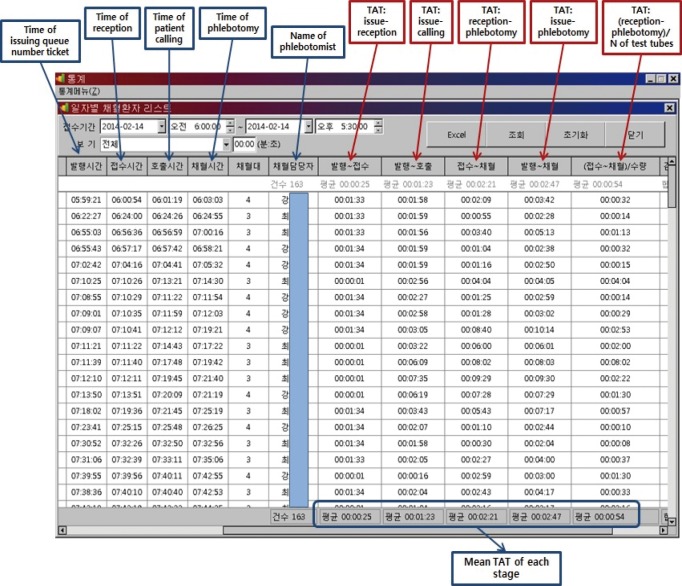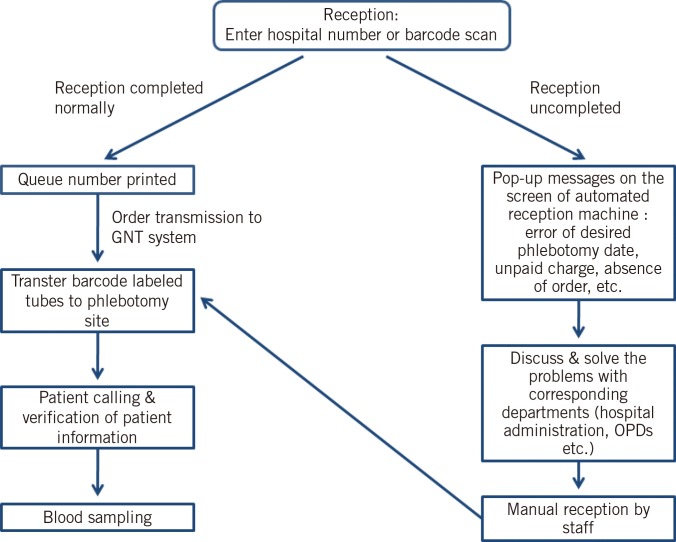Ann Lab Med.
2016 Jan;36(1):49-54. 10.3343/alm.2016.36.1.49.
Efficiency of an Automated Reception and Turnaround Time Management System for the Phlebotomy Room
- Affiliations
-
- 1Department of Laboratory Medicine, Soonchunhyang University Hospital, Seoul, Korea. jwshin@schmc.ac.kr
- 2Department of Laboratory Medicine, Kangwon National University School of Medicine, Chuncheon, Korea.
- KMID: 2373497
- DOI: http://doi.org/10.3343/alm.2016.36.1.49
Abstract
- BACKGROUND
Recent advances in laboratory information systems have largely been focused on automation. However, the phlebotomy services have not been completely automated. To address this issue, we introduced an automated reception and turnaround time (TAT) management system, for the first time in Korea, whereby the patient's information is transmitted directly to the actual phlebotomy site and the TAT for each phlebotomy step can be monitored at a glance.
METHODS
The GNT5 system (Energium Co., Ltd., Korea) was installed in June 2013. The automated reception and TAT management system has been in operation since February 2014. Integration of the automated reception machine with the GNT5 allowed for direct transmission of laboratory order information to the GNT5 without involving any manual reception step. We used the mean TAT from reception to actual phlebotomy as the parameter for evaluating the efficiency of our system.
RESULTS
Mean TAT decreased from 5:45 min to 2:42 min after operationalization of the system. The mean number of patients in queue decreased from 2.9 to 1.0. Further, the number of cases taking more than five minutes from reception to phlebotomy, defined as the defect rate, decreased from 20.1% to 9.7%.
CONCLUSIONS
The use of automated reception and TAT management system was associated with a decrease of overall TAT and an improved workflow at the phlebotomy room.
Keyword
MeSH Terms
Figure
Reference
-
1. Streitberg GS, Angel L, Sikaris KA, Bwititi PT. Automation in clinical biochemistry: core, peripheral, STAT, and specialist laboratories in Australia. J Lab Autom. 2012; 17:387–394. PMID: 22661200.2. Hawkins RC. Laboratory turnaround time. Clin Biochem Rev. 2007; 28:179–194. PMID: 18392122.3. GNT system introduction. Update on Jan 2014. http://www.gobizkorea.com/catalog/product_view.jsp?blogId=1308180833&listStyle=A&objId=1093197.4. Da Rin G. Pre-analytical workstations: a tool for reducing laboratory errors. Clin Chim Acta. 2009; 404:68–74. PMID: 19302988.5. Wallin O, Söderberg J, Van Guelpen B, Stenlund H, Grankvist K, Brulin C. Preanalytical venous blood sampling practices demand improvement--a survey of test-request management, test-tube labelling and information search procedures. Clin Chim Acta. 2008; 391:91–97. PMID: 18342012.6. Hawker CD. Laboratory automation: total and subtotal. Clin Lab Med. 2007; 27:749–770. viPMID: 17950896.7. Lippi G, Guidi GC. Risk management in the preanalytical phase of laboratory testing. Clin Chem Lab Med. 2007; 45:720–727. PMID: 17579523.8. Georgiou A, Westbrook JI. Computerised order entry systems and pathology services--a synthesis of the evidence. Clin Biochem Rev. 2006; 27:79–87. PMID: 17077878.9. Georgiou A, Westbrook J, Braithwaite J, Iedema R. Multiple perspectives on the impact of electronic ordering on hospital organisational and communication processes. HIM J. 2006; 34:130–135. PMID: 18216417.10. Stablein D, Welebob E, Johnson E, Metzger J, Burgess R, Classen DC. Understanding hospital readiness for computerized physician order entry. Jt Comm J Qual Saf. 2003; 29:336–344. PMID: 12856555.11. Davidson EJ, Chismar WG. Planning and managing computerized order entry: a case study of IT-enabled organizational transformation. Top Health Inf Manage. 1999; 19:47–61. PMID: 10387655.12. Baron JM, Dighe AS. Computerized provider order entry in the clinical laboratory. J Pathol Inform. 2011; 2:35. PMID: 21886891.13. Pantanowitz L, Henricks WH, Beckwith BA. Medical laboratory informatics. Clin Lab Med. 2007; 27:823–843. viiPMID: 17950900.14. Valenstein P, Meier F. Outpatient order accuracy. A College of American Pathologists Q-Probes study of requisition order entry accuracy in 660 institutions. Arch Pathol Lab Med. 1999; 123:1145–1150. PMID: 10583917.
- Full Text Links
- Actions
-
Cited
- CITED
-
- Close
- Share
- Similar articles
-
- Reducing the Reporting Time by Improving Laboratory Processing for Inpatient Routine Chemistry Tests
- Analysis of Turnaround Time for Packed Red Blood Cell Delivery by Laboratory Information System: Shortening of Turnaround Time Through Quality Improvement Program
- Blood pressure difference between reception room and consultation room in outpatients of family medicine
- Reorganization of Automated Outpatient Laboratory to improve Total
- LAN Based Hospital Information System (II): Computerization of Blood Collection Room to Reduce Clinical Order Turnaround Time





